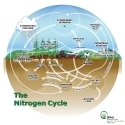13 Feb 2011
N dynamics under elevated carbon dioxide in the Australian FACE experiment
An update on the effects of elevated carbon dioxide presented at the Australian Society of Agronomy conference, Christchurch, New Zealand, November, 2010
N dynamics under elevated carbon dioxide in the Australian FACE experiment
Robert M Norton1,2, S K Lam2,3, D Chen3, G. Fitzgerald4, R Armstrong4
1 International Plant Nutrition Institute, 54 Florence St, Horsham, Victoria, Australia. Email: rnorton@ipni.net
2 Department of Agriculture and Food Systems, The University of Melbourne, Private Box 260, Horsham, Victoria 3401, Australia.
3 Department of Resource Management and Geography, The University of Melbourne, Victoria, 3010, Australia.
4 Victorian Department of Primary Industries, Private Bag 260, Horsham, Victoria, 3401, Australia.
Abstract
The Australian Grains Free Air Carbon Dioxide Enrichment (AGFACE) facility was established to compare wheat growth, yield and development under ambient (~380 mol/mol and elevated (~550 mol/mol) carbon dioxide (a[CO2] and e[CO2], respectively). Experiments on N uptake and location have been undertaken to estimate how e[CO2] and a changing climate could affect N supply and demand for annual crop production systems. These experiments were undertaken at Horsham in the Victorian Wimmera in 2007, 2008 and 2009 with two cultivars (Yitpi and Janz), two sowing times and two irrigation treatments, although results from only 2008 and 2009 are presented.
When grown under e[CO2], wheat crops showed higher crop biomass at the end of tillering, anthesis and maturity. Although plant and grain N contents declined, crop N uptake was 24% higher with e[CO2]. Stubble C:N ratio was not affected by e[CO2]. Generally, total plant N and leaf specific N levels were lower under e[CO2] at stem elongation and anthesis although at maturity straw C:N ratio was not altered.




